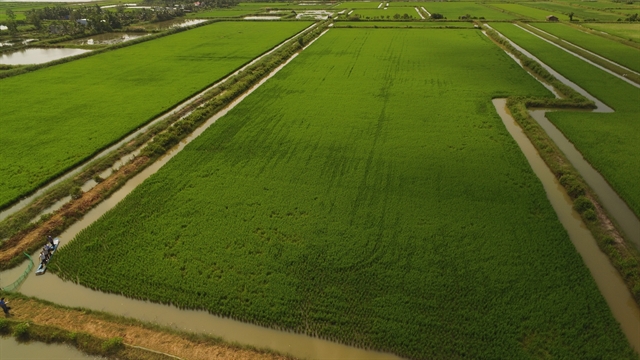 Society
Society

After five years of restructuring, agriculture in the southernmost province of Cà Mau is geared to adapt to climate change and exploit all the natural advantages available.

|
| An 80ha organic rice field in Cà Mau Province’s Thới Bình District. — VNA/VNS Photo Hồng Nhung |
CÀ MAU — After five years of restructuring, agriculture in the southernmost province of Cà Mau is geared to adapt to climate change and exploit all the natural advantages available.
The value of agriculture, aquaculture and forestry production has increased by an average of 4.35 per cent a year for the past five years, according to the local Department of Agriculture and Rural Development.
The key products are shrimp, mud crab, high-quality rice, and timber.
Cà Mau is one of the country’s five provinces most affected by climate change. But the country’s largest shrimp producer has rapidly developed various kinds of farming models for the crustacean such as intensive farming, super - intensive farming, advanced extensive farming, shrimp – rice farming, and shrimp – forest farming.
Under the shrimp – forest farming model, for instance, farmers use 40 per cent of a mangrove forest area for raising shrimp and 60 per cent for planting trees.
Lê Minh Tỵ, a farmer in Ngọc Hiển District’s Rạch Gốc Town, said under this model he only had to buy shrimp fry and not even food for the animals as they eat the natural food available in the mangrove forest.
The shrimp living in mangrove forests are healthy and have few diseases, according to Tỵ.
The creatures bred under this and the shrimp – rice farming model are considered organic shrimp.
Vũ Thành Chung of Ngọc Hiển District said he raised 5ha of organic shrimp and sold his entire output to the Minh Phú Seafood Corporation and earned VNĐ200 million (US$8,600) a year.
The corporation has signed deals with nearly 100 farmers in Ngọc Hiển to breed organic shrimp on a total area of 500ha.
It buys the crustaceans from the farmers at 10 – 15 per cent higher than market prices.
Lý Hoàng Tiến, chairman of the Ngọc Hiển People’s Committee, said: “Organic breeding of shrimp in mangrove forests reduces pollution, helps adapt to climate change and ensure a steady output.”
The province has 17,000ha under shrimp – forest farming model, including 1,200ha that meet Aquaculture Stewardship Council (ASC) quality standards.
According to Trần Văn Thức, deputy director of the department, the province expects to increase the area to 19,000ha next year.
It has more than 70,000ha of mangrove forests.
It also has 9,600ha of acacia and 9,400ha of cajuput for producing timber.
With the use of advanced farming techniques to create seedlings and intensive farming to grow cajuput forests, farmers have reduced the period required to harvest the wood from 15 – 20 years earlier to six-eight years now.
The quality of forest wood also increased two- or three-fold, the department said.
Nguyễn Văn Thư, deputy head of the province’s Forest Protection Sub-department, said there were 19,000ha of quality forests by the end of last year.
They generate 150 – 250cu.m of wood per hectare four to five years after planting and farmers can earn VNĐ130 - 200 million ($5,600 – 8,600) per hectare, according to the official.
More than 1,000ha of forests have been certified by the Forest Stewardship Council.
Linkage
Many farmers in the province have tied up among themselves and with processors of key products, helping improve their incomes and provide quality products to the latter.
Twenty-two shrimp processors have contracts with 15 shrimp co-operatives and co-operative groups.
The contracts are also for developing shrimp farming areas meeting international standards.
Nguyễn Văn Lâm, chairman of the Cái Bát Co-operative in Cái Nước District, said its 350ha organic shrimp – rice area had received ASC certification.
The certification was possible due to the linkages among farmers in the co-operative and with processors, he said, adding that they helped improve the yield and quality of the shrimp and reduce diseases.
The province had 14,000ha of organic shrimp – rice farms as of October, according to the department.
Châu Công Bằng, deputy director of the department, said the province had not fully exploited its agricultural potential and had a number of limitations.
They included tardy zoning plans, lack of infrastructure and the low use of advanced farming techniques.
But the province was trying to popularise the use of hi-tech farming and seeking to protect the environment.
It offered incentives to companies investing in concentrated farming areas.
It had also created linkages between farmers and processors to guarantee outlets for the former and improve quality.
The department has earmarked hi-tech agriculture zones in Năm Căn, Ngọc Hiển, Đầm Dơi, and U Minh districts. VNS




